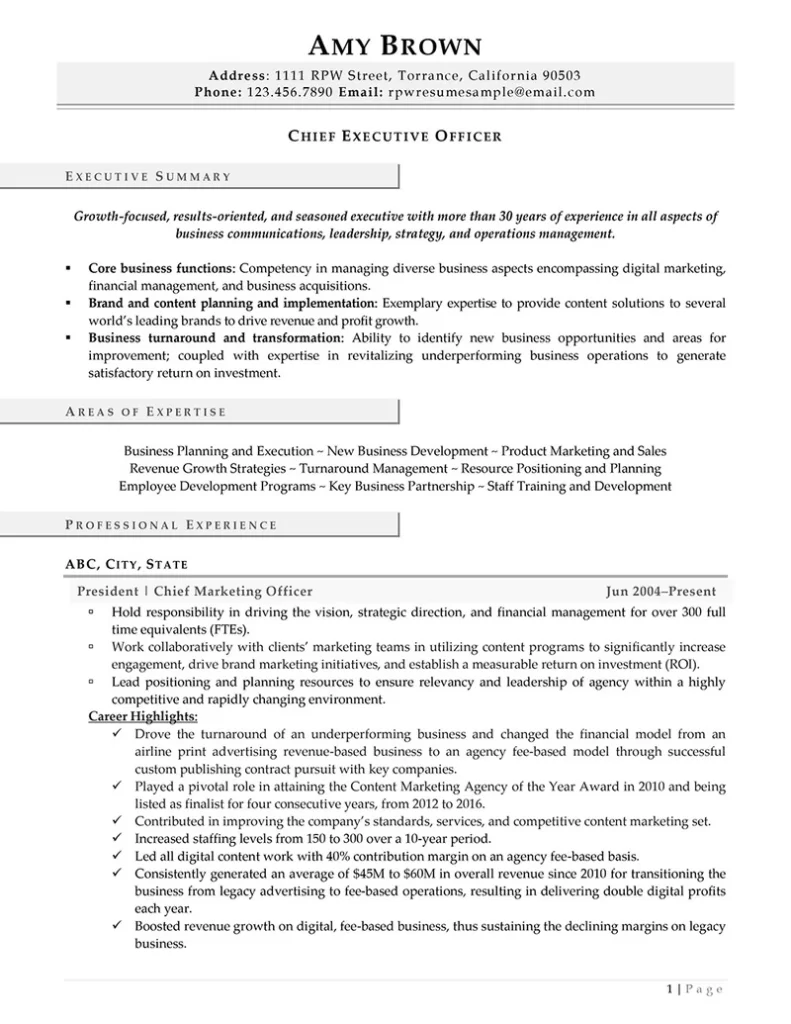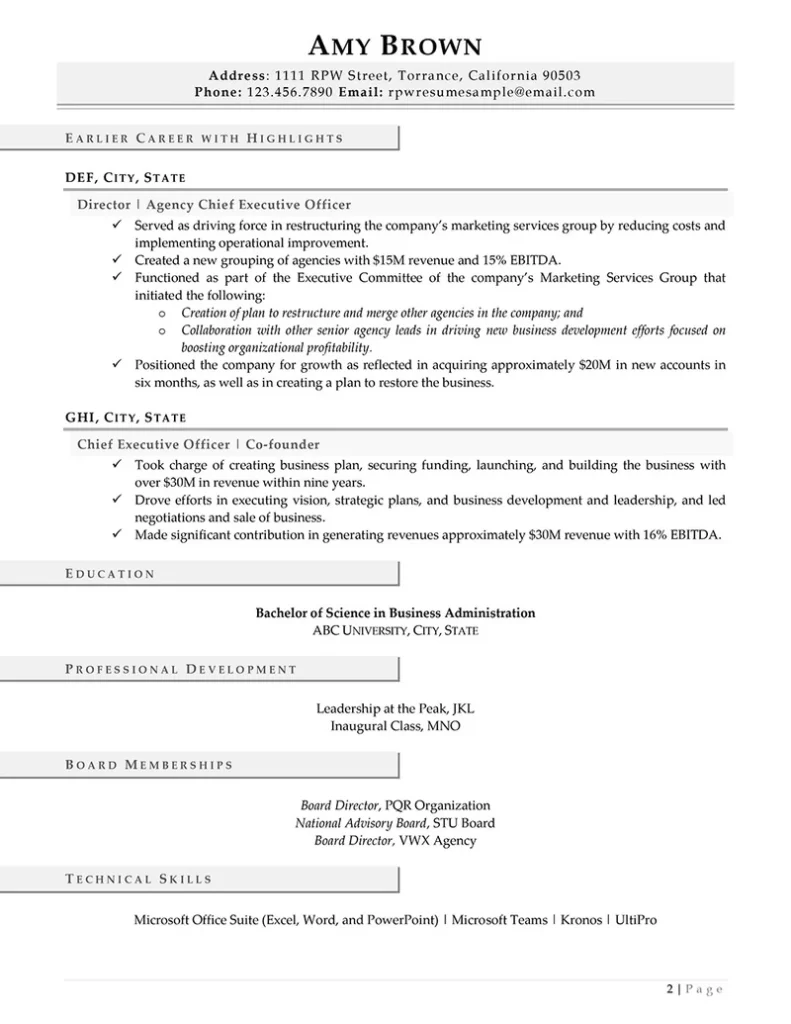Small companies and large enterprises have one thing in common: The person at the top is ultimately accountable for the success or failure of the company. The chief executive officer, or CEO, of bigger organizations, particularly publicly listed corporations, is the highest-ranking executive, whereas small enterprises are often formed and operated by their owners. If you are eyeing for the C-level position, you will need an impressive CEO resume to impress the management and board of directors.
When comparing the positions of CEO and owner, there are numerous parallels and significant contrasts. For example, critical thinking and interpersonal communication abilities are generally required of CEOs and business owners. They both have important duties, such as hiring personnel for high-level jobs in respective companies.
According to U.S Bureau of Labor Statistics, management occupations are expected to expand at a rate of 9% from 2020 to 2030, roughly the same as all other occupations, resulting in around 906,800 new jobs. The development of new organizations and the expansion of existing ones are likely to stimulate employment growth, requiring more people to run these activities.
What is a Chief Executive Officer?
The ultimate responsibility of a chief executive officer or (CEO) is to ensure that shareholders get a return on their investment. This entails legal obligations to shareholders, such as the responsibility of care and loyalty. Such legal duties are meant to encourage openness and confidence, as well as to safeguard critical business stakeholders. The board of directors provides advice to CEOs as the top executive of big corporations on the organization’s vision and goals.
What are the Duties of a Chief Executive Officer?
The function of the CEO varies based on the size, culture, and corporate structure of the organization. A CEO often deals exclusively with very high-level strategic choices and those that guide the company’s overall growth in major organizations. Some common responsibilities of a chief executive officer include:
- Developing, expressing, and putting into action the organization’s vision, purpose, and overall strategy
- Leading the formulation and execution of the organization’s overarching strategy
- Creating and implementing a strategic plan that directs the firm or organization’s course
- Assessing the organization’s success in achieving objectives
- Considering possible purchases to boost shareholder value

How Do You Become a Chief Executive Officer?
The CEO is always the highest-ranking executive manager in an organization, with overall responsibility for the organization’s performance and ultimate decision-making authority. While each chief executive’s daily responsibilities differ, the position’s broad vision serves as the foundation for all departments’ operations.
Other executive executives, such as presidents, vice presidents, and directors, are led, guided, directed, and evaluated. Employer needs differ significantly in terms of industry-specific education and training. Most companies prefer to appoint CEOs who have at least a bachelor’s degree and a significant amount of experience. Many businesses prefer to employ from inside rather than outside.
What to Include on Your CEO Resume
Many of us grew up thinking about becoming the CEO of a successful firm. As CEO, you’re someone who can see the broad picture while also paying attention to responsibilities that make operations work smoothly. Because the future of a company, including revenues, lies on your shoulders, you must be a competent communicator and leader who can delegate, challenge, and steer others toward the firm’s objective. Most importantly, you must highlight your qualifications on your resume. Here’s what to add and put on your resume.
Updated Contact Information
Write your complete name, complete postal address with ZIP code, phone number, and email address at the top of your resume. You may also add your LinkedIn profile URL, if you have one.
Specific Target Job
It’s also known as a “career tag” since it informs hiring managers and recruiters about the sort of work you are applying for.
Qualifications Profile / Executive Profile
When applying for senior-level roles such as chief executive officer or president of a corporation, a CEO resume is used. As an executive, you’ll want to make sure your resume reflects your authority and expertise on the topmost section of your resume or the profile section.
Expert Tip:
When writing your summary, steer away from the resume objective-type statement. Instead, use compelling titles and headlines to catch the hiring manager’s attention.
Areas of Expertise or the Skills Section
This part allows you the chance to highlight your skills, expertise, and experience. You can demonstrate to hiring managers what you can bring to their firm and if you possess the necessary abilities.
Related Article:
Professional Experience
While you may have a long list of great accomplishments, only include those that are relevant to the firm and job you are going for, as well as those that demonstrate your managerial talents. A useful achievement to highlight on a CEO resume would be to include a new task responsibility and how to apply it. Use numbers to provide hiring managers a solid notion of the influence you had while writing about your accomplishments.
Education
The education section highlighted on your resume should be clear. In reverse chronological sequence, from recent years of completion to oldest. List the applicable degrees received from universities you attended. Mention any academic awards or other notable accomplishments and distinctions.
Licenses, Certifications, and Training
Any diplomas, qualifications, or internships that are related to your leadership growth should also be listed in the certifications section. Professional memberships provide similar opportunities to broaden and upgrade your knowledge and abilities. Don’t miss anything that distinguishes you as someone who prioritizes continual learning in order to stay current in your industry and on top of your game.

How to Write a Resume for a CEO Position
Choose carefully which ones to include on your CEO resume. Knowing which ones to leave out may be more difficult than you think. To make it simple to decide, pay special attention to keywords (typically skill-specific buzzwords) that precisely fit the job criteria. Additional information about the employer’s skills requirements should bolster your decision.
1. Use a simple yet attractive design and layout.
A visually appealing CEO resume might increase your chances of getting an interview. As you enter the meeting room, imagine the best-case scenario occurring. Anything less than a polished professional appearance may dissuade readers from spending more time than their quick glimpse allows. Strive for a simple aesthetic impact: flawlessly tidy, clean, and streamlined. Make sure your resume is free of ornamental patterns, excessive borders, and fancy font choices.
2. Select the best resume format.
The sections of your resume will be by your experience, credentials, and skills. The chronological style is the best choice if you already have years of experience. Focus on demonstrable advantages to previous employers that you can give again when deciding which talents and accomplishments to mention or exclude.
3. Emphasize your leadership skills.
Leadership is a qualification that establishes you as part of an effective management that aids in increasing work efficiency and achieving corporate objectives. Leadership abilities are essential regardless of the sort of position you’re seeking for or the size of the firm. When it comes to demonstrating leadership abilities on a resume, what you must do is to present concrete examples backed by experiences.
4. Include resume keywords.
Keywords in your resume are essential for getting your resume seen by companies. You may improve your chances of getting a job interview by using keywords in your resume and cover letter. Keywords are words or brief phrases that are associated with certain job needs for applicant tracking system. A hiring manager looks for talents, abilities, qualifications, and attributes in an applicant. The closer you are to a match, the more likely you are to be screened for an interview.
5. Show off your accomplishments backed by data.
A competent leader’s qualities extend beyond the capacity to encourage and lead people to work efficiency and precise, quantifiable results. Always use statistics and real facts to quantify your results when writing about past positions.
6. Proofread and edit your CEO resume.
Read your CEO resume several times before submitting it. This allows you to check for, identify, and correct mistakes. Remember that your summary section must showcase a little of your individuality as well as your professional approach. As a leader, you must demonstrate that you are dependable and quick-witted.
Expert Tip:
After proofreading your document, you can use a free online resume review to check if your resume has what it takes to impress hiring managers.
Chief Executive Officer or CEO Resume Example
Let’s get right to the point. Here’s a CEO resume example to help you get started. See how our skilled resume writers define career highlights and build a successful resume by looking at one of our resume samples. So, what does a CEO resume look like? Check our sample below.


Let the Experts Write Your CEO Resume to Ace Your Job Search
The importance of workplace leadership is paramount to a company’s success. Because your resume will be your initial point of contact with an organization, make sure it showcases your abilities to lead and inspire people in a positive and productive way. Even the language you choose may help you demonstrate your leadership abilities.
It is not simple to get there. As a result, hiring an executive resume writer is a feasible option. You may also let our experts review your resume for free!





